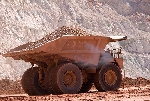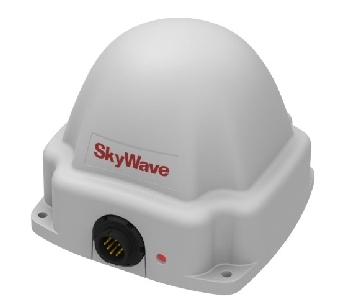
Over the last two decades, nearly 12 per cent of all new gold discoveries have been in West Africa. While these discoveries spur investments in the region, fluctuating gold prices require that mining companies keep an eye on capital and operational expenditures.
In the remote regions of Western Ghana, a gold mining company was faced with the dilemma of choosing between building a new gold mill at a mining site where new gold deposits were recently discovered versus milling at an existing site located 80 kilometers from the new mining site. Building a new gold mill would carry a substantial initial cost in infrastructure so the mining company decided instead that it made financial sense to transport ore to their existing mill site. While this decision helped keep major capital investment costs down, three major challenges promptly emerged as ore began moving from the obscure pit location to the mill site:
Solution for Tracking Vehicles 
These transportation and labor issues could not be solved with a cellular-based GPS tracking and monitoring application. Western Ghana currently does not possess the consistent and reliable cellular communication coverage that is required for security-based applications. This led local provider Asset Management and Wireless Tracking Company, ATRAMS, to develop a tracking solution for the mining company that uses satellite/cellular messaging terminals to transmit data between office staff, site operators and drivers.
With M2M satellite communications, the mining company can now track and monitor trucks at all times, regardless of the quality of the cellular network. The solution uses SkyWave communication terminals to collect data from fuel-level and cargo-weight sensors, which along with the GPS position, is sent via text messaging for monitoring purposes.
This technology enables two-way communication between drivers and the office when there is no cellular coverage. “Drivers are now able to let the appropriate recovery teams know if there is a road obstruction, a malfunction, or other issue that is slowing or halting movement,” explained Myles Owusu, ATRAMS Finance and Operations, Africa. The solution also allows dispatch to warn drivers of upcoming adverse weather conditions, changes in the route and any other relevant information.
At the head office, personnel work from a web portal to send and receive messages, which may include driver monitoring and tracking data or texts from drivers. Canned messages are preloaded for recurring tasks and issues. A two word text message “Fallen tree” or “Stuck in mud” gives the recovery team all the information they need to solve the issue on the first visit.
Benefits of Tracking Haul Vehicles
With real time vehicle monitoring and driver scheduling for ore haulage, managers know where vehicles are at all times and are informed immediately if a truck cannot move forward. This has cut the average travel time between the mine and the mill significantly.
The mining company has also seen a reduction in ore theft and fuel theft/siphoning. With the installation of fuel and cargo sensors, managers are now able to monitor changes in cargo weight as well as fuel usage in real time; this has reduced operating losses as well as increased the efficiency of the working team.
Beyond Tracking Haul Vehicles
Satellite solutions can be used for more than just tracking haul vehicles. Mine sites have a variety of equipment including excavators, loaders, dozers and graders that would benefit from close monitoring and tracking.
One source stated that, on average, a truck taken offline for a shift has a financial production impact of $35,000. For a shovel, it can be many times that amount. Investing in technology that remotely automates and monitors the operation of a $3.4M haul truck or a $30M shovel can help to reduce overall operation and maintenance costs as well as keep the machines working longer.
Beyond position reporting, satellite messaging terminals can also be used to monitor the health of heavy equipment. Known as telemetry monitoring, tracking how the vehicle is being used and functioning allows equipment supervisors to perform tasks like asset health monitoring, maintenance planning and proactive operator training.
Depending on the system chosen, heavy equipment health management can provide the following reports:
Satellite communications terminals can also be used for alert notifications where a manager can track unauthorized use by being notified via text message or email if a vehicle has violated a curfew or specific geographical boundary (geofence). Alerts can also be created to notify when the battery on a vehicle is low or being tampered with.
By remotely monitoring heavy equipment use, maintenance staff can track the performance of the entire mining fleet and receive early warnings of developing problems before a catastrophic failure occurs.
Monitoring Water and Fixed Equipment
Satellite technology that is used for tracking mobile equipment can also be used for monitoring fixed mining equipment and sensors. As an example, water ingress is an issue that must constantly be dealt with at both underground and pit mining sites. Dewatering or the removal of excess water is a function that needs to be closely monitored and controlled to keep mining operations working.
Dewatering, centrifugal, submersible, slurry and piston pumps, as well as collection pumps, are a few examples of equipment used in mining operations to move and pump water out. Keeping them at optimal working conditions is necessary for effective dewatering.
Satellite messaging terminals connected to sensors can be used to monitor water levels as well as to remotely turn on and off dewatering equipment that is located in areas where other wireless communications services are unreliable or are not available.
M2M satellite communications can also be used to:
Beyond fleet management and water equipment, satellite messaging terminals can also be used to monitor dust levels, which is a threat to the moving parts of heavy equipment, road visibility, and the health of workers and the local population.
Automated monitoring of equipment and assets is an inexpensive way to decrease operating costs, reduce losses, ensure equipment is working and help keep mining operations at peak production levels.